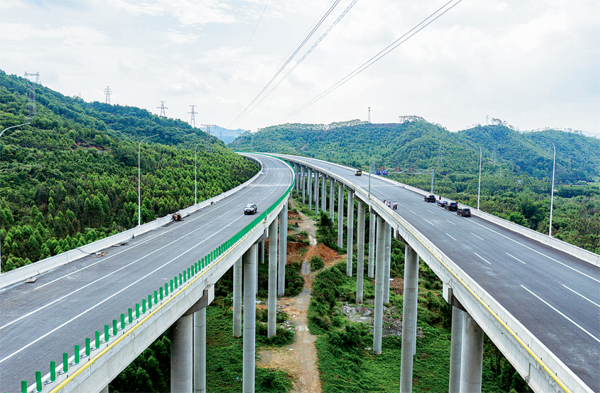Highway travel just got a lot easier down south

The Shaoguan-Xinfeng Expressway, built with an investment of 12.8 billion yuan ($1.98 billion), opens to traffic on Tuesday in Guangdong province. It links with the Guangdong-Hong Kong-Macao Greater Bay Area. HU XIAO/FOR CHINA DAILY
A new two-way, six-lane expressway negotiating mountainous terrain in northern Guangdong province in South China, with a massive investment of 12.8 billion yuan ($1.98 billion), officially opened to traffic on Tuesday, linking the region with the Guangdong-Hong Kong-Macao Greater Bay Area.
The 82-kilometer Shaoguan-Xinfeng Expressway-built by State-owned China Tiesiju Civil Engineering Group Co Ltd with construction beginning in October 2017-runs between Xinjiang township, Wengyuan county, Shaoguan and Lantian township, Longmen county, Huizhou. It passes through Xinfeng county under Shaoguan in the middle.
After more than 1,300 days of construction, some 10,000 CTCE employees helped to complete the project six months ahead of schedule, said Tang Mingqiang, director of Shaoguan's transportation bureau.
"This hard-won project has benefited from the hard work and sweat of CTCE workers. Now it's fully completed, and worthy of gratitude, as cities and towns along the route can usher in new development opportunities, and people will enjoy more convenient travel," Tang said.
As one of the Chinese regions with the highest degree of opening-up and the strongest economic vitality, the GBA covers Hong Kong, Macao and nine cities in Guangdong-Huizhou, Guangzhou, Shenzhen, Dongguan, Zhongshan, Zhuhai, Foshan, Jiangmen and Zhaoqing.
As an important north-south conduit serving Shaoguan, the new expressway further links the Huizhou with the GBA, Tang added.
While connecting with the Beijing-Hong Kong-Macao Expressway in the north, it links the Shantou-Kunming and Daqing-Guangzhou expressways in the middle, while at the southern end, it links up with the Wuhan-Shenzhen Expressway.
"The quality of the expressway is excellent, and meets all conditions for opening to traffic," said Xu Xinguo, president of Guangdong Shaoguan-Xinfeng Expressway Co Ltd, noting that travel distance between Shaoguan and Xinfeng can be shortened by 79 km, thus saving at least 40 minutes in driving time.
It is the first Public-Private Partnership project in Guangdong. On Sept 30, 2016, Shaoguan set up Guangdong Shaoguan-Xinfeng Expressway Co Ltd to take charge of operations.
There are 11 interchanges and two service areas along the whole route, Xu said.
"In our country, expressways are a preferred and often chosen means of transportation," said driver Guo Qiang, adding that locals can now transport regional delicacies, such as plums, dragon fruit, peaches and sugar cane, more quickly to the GBA.
Previously, due to mountainous terrain, transportation between Wengyuan and Longmen mainly relied on a two-lane highway, which was dominated by slow-moving, heavy trucks and hidden road hazards, said Wang Jinliang, an employee of CTCE Fifth Engineering Co Ltd.
Dominated by mountains and basins with undulating terrain, Wengyuan is known as "the south gate of northern Guangdong".There are 13 peaks, each with an altitude of over 1,000 meters above sea level, making speedy travel difficult for locals.
Its provincial peer, Longmen-known as a "land of mountains"-also involves challenging road conditions, Wang said.
With the new expressway, more GBA residents can more conveniently visit major regional attractions. Key tourist attractions in Wenyuan include Donghua Mountain, Water Dragon Palace, Fairy Lion Cave and Shuhu Xinba Hakka Group Buildings, while in Longmen, they include Nankun Mountain, Laurel Peak Mountain, and Three-Stockade Valley Resort.
Investors can also benefit, as it now seamlessly links the region with the GBA, Wang said.
"The project was difficult for us, mainly due to the local terrain, as there are so many hills and valleys to deal with," said Wang Jianhua from CTCE Fifth Engineering Co Ltd who is in charge of the whole project. Wang added that they built 49 bridges and dug nine tunnels for the expressway, and the length of the bridges and tunnels accounted for 47 percent of the entire line.
"Take the 7.9-km Songshan Tunnel for example. As it was a six-lane expressway, unlike an ordinary four-lane one, we needed to make the tunnel much wider, and it took us 1,288 days to finish it," he said.
"But the most dangerous one was the Shizishan (Lion Hill) Tunnel. Though it was only 2.94 km long, we also spent three years on it," Wang said.
"We did have some frustrations during the process. As the COVID-19 first hit Guangdong in early 2020 around Chinese Lunar New Year, when we sent our employees back home for family reunions, we could not call them back in good time due to travel restrictions. This resulted in some delays for us," Wang said.
The expressway has a designed maximum speed of 100 km per hour.



 Print
Print Mail
Mail

